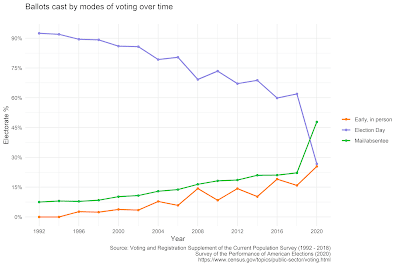In the 2020 United States presidential election, Joe Biden, the Democratic candidate, "received" approximately 81 million popular votes. How did Joe do this without any debates or campaign rallies? This statistic is kind of hard to believe when you look at the historical data above. Historically absentee voting is around 20% nationwide, but in 2020 it jumped up 27% (from 20%) to 47% and this was the difference in the amount of votes that the winners had from the 2016 election.
This incredible election result was an increase of almost 30% more votes than one of the most popular Presidents of all time Barack Obama. Barack Obama, the 44th President of the United States, won two presidential elections. Here are the approximate popular vote counts he received in each of his election wins:
- 2008 Election: Barack Obama, the Democratic candidate, received approximately 69.5 million popular votes.
- 2012 Election: Barack Obama, again the Democratic candidate, received approximately 65.9 million popular votes.
The Evolution of Voting by Mail and Absentee Voting
Over the last four decades, the landscape of voting by mail and absentee voting has undergone significant transformations. From technological advancements to evolving election policies, the way citizens cast their votes has evolved to ensure greater accessibility and participation in the democratic process. In this article, we delve into the historical journey of voting by mail and absentee voting, highlighting key changes and their implications.
Early Beginnings:
Voting by mail, also known as absentee voting, traces its origins back to the Civil War era when soldiers cast their votes from the battlefield. These early efforts laid the foundation for remote voting, setting the stage for further developments.
Incremental Changes:
Over the years, incremental changes were made to absentee voting processes, with states adopting varying rules and regulations. Initially, absentee voting was primarily reserved for individuals who were physically unable to visit polling stations on Election Day. However, this began to expand to include other circumstances as well.
Expansion of Eligibility:
In the 1980s and 1990s, many states broadened the eligibility criteria for absentee voting. This shift allowed individuals to vote by mail if they were traveling, attending school away from home, or had work commitments that prevented them from being present on Election Day.
Ever since California instituted no-excuse absentee voting, several states have taken the next step and allowed all residents to request an absentee ballot for every election. These permanent absentee states now have even greater use of absentee ballots. In 2018, the EAVS reported that 68% of voters in states with permanent absentee laws voted with an absentee ballot.
Technological Advancements:
The turn of the 21st century saw significant technological advancements that transformed the voting landscape. Online applications for absentee ballots, electronic transmission of ballots to overseas voters, and the use of barcode systems for tracking ballots became increasingly prevalent, streamlining the process and enhancing security.
The 2020 Paradigm Shift:
The global COVID-19 pandemic in 2020 accelerated the adoption of voting by mail. Concerns about in-person voting's safety led many jurisdictions to expand access to mail-in voting options. Some states even conducted elections entirely by mail. This shift sparked debates about election integrity and led to a renewed focus on secure processes.
Legislative Reforms:
The aftermath of the 2020 election witnessed a wave of legislative reforms aimed at either expanding or restricting mail-in voting. Some states moved to make pandemic-induced changes permanent, while others imposed new requirements, such as stricter ID verification for absentee voters.
Challenges and Controversies:
The evolution of voting by mail and absentee voting hasn't been without challenges. Concerns about voter fraud, delays in ballot delivery, and the potential for disenfranchisement have spurred debates, prompting policymakers to strike a balance between accessibility and security.
Looking Ahead:
As we move forward, the future of voting by mail and absentee voting remains a topic of interest. Continued advancements in technology, ongoing legislative debates, and the ebb and flow of public opinion will shape the trajectory of these voting methods.
Conclusion
The last 40 years have witnessed remarkable changes in the realm of voting by mail and absentee voting. From humble beginnings rooted in wartime necessity to a contemporary landscape shaped by technological progress and societal shifts, these voting methods have come a long way. As we navigate the evolving landscape of democracy, it's essential to find common ground that ensures both accessibility and the integrity of the electoral process.
Related articles:
One of the most active search terms on election day is "provisional ballots". Why?












